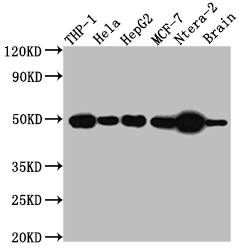The coding sequence for the TACR1 monoclonal antibody (isolated by immunizing animals with the synthesized peptide derived from human Neurokinin 1 Receptor) was cloned into the plasmids and then transfected into cell lines for in vitro expression. The product underwent affinity-chromatography-mediated purification to get the TACR1 recombinant monoclonal antibody. This TACR1 antibody is a rabbit IgG. It is suitable for the detection of TACR1 protein from human and mouse samples. And it can be used in ELISA and WB applications.
TACR1 is a neuronal transmitter, that, when activated by substance P (SP), is associated with inflammation, cell migration, tumoral angiogenesis, and cell proliferation upon activation by binding to substance P (SP). The SP-TACR1 receptor system has recently been considered a promising anticancer target in neuroblastoma (NB).




